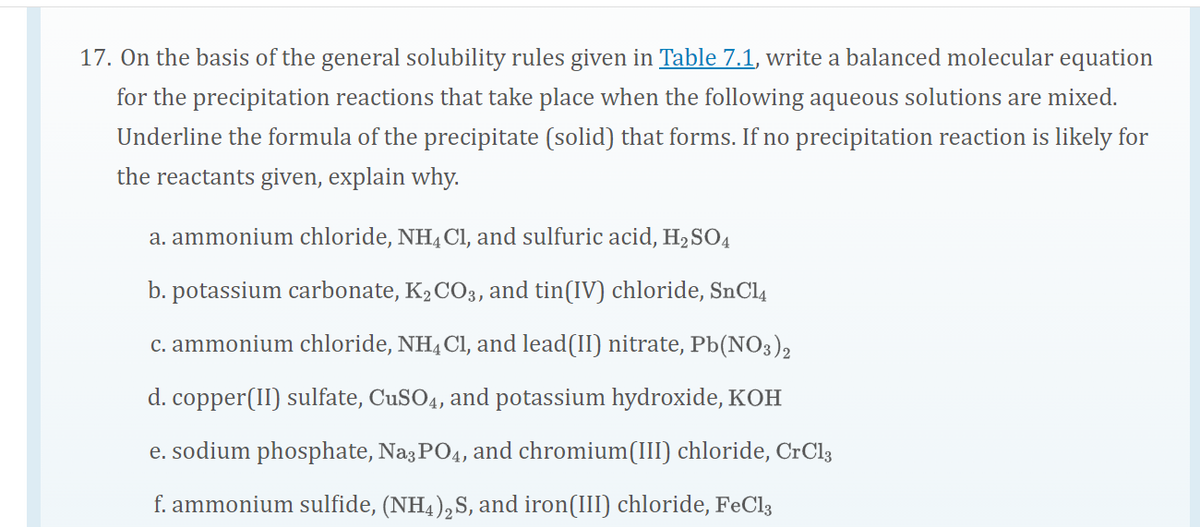17. On the basis of the general solubility rules given in Table 7.1, write a balanced molecular equation for the precipitation reactions that take place when the following aqueous solutions are mixed. Underline the formula of the precipitate (solid) that forms. If no precipitation reaction is likely for the reactants given, explain why. a. ammonium chloride, NH4CI, and sulfuric acid, H2SO4 b. potassium carbonate, K2CO3, and tin(IV) chloride, SnCl4 c. ammonium chloride, NH¼CI, and lead(II) nitrate, Pb(NO3)2 d. copper(II) sulfate, CuSO4, and potassium hydroxide, KOH e. sodium phosphate, Na3 PO4, and chromium(III) chloride, CrCl3 f. ammonium sulfide, (NH4),S, and iron(III) chloride, FeCl3
17. On the basis of the general solubility rules given in Table 7.1, write a balanced molecular equation for the precipitation reactions that take place when the following aqueous solutions are mixed. Underline the formula of the precipitate (solid) that forms. If no precipitation reaction is likely for the reactants given, explain why. a. ammonium chloride, NH4CI, and sulfuric acid, H2SO4 b. potassium carbonate, K2CO3, and tin(IV) chloride, SnCl4 c. ammonium chloride, NH¼CI, and lead(II) nitrate, Pb(NO3)2 d. copper(II) sulfate, CuSO4, and potassium hydroxide, KOH e. sodium phosphate, Na3 PO4, and chromium(III) chloride, CrCl3 f. ammonium sulfide, (NH4),S, and iron(III) chloride, FeCl3
World of Chemistry, 3rd edition
3rd Edition
ISBN:9781133109655
Author:Steven S. Zumdahl, Susan L. Zumdahl, Donald J. DeCoste
Publisher:Steven S. Zumdahl, Susan L. Zumdahl, Donald J. DeCoste
Chapter8: Reactions In Aqueous Solutions
Section: Chapter Questions
Problem 12A
Related questions
Question
100%

Transcribed Image Text:17. On the basis of the general solubility rules given in Table 7.1, write a balanced molecular equation
for the precipitation reactions that take place when the following aqueous solutions are mixed.
Underline the formula of the precipitate (solid) that forms. If no precipitation reaction is likely for
the reactants given, explain why.
a. ammonium chloride, NH4C1, and sulfuric acid, H2SO4
b. potassium carbonate, K2 CO3, and tin(IV) chloride, SnCl4
c. ammonium chloride, NH, Cl, and lead(II) nitrate, Pb(NO3),
d. copper(II) sulfate, CUSO4, and potassium hydroxide, KOH
e. sodium phosphate, Na3 PO4, and chromium(III) chloride, CrCl3
f. ammonium sulfide, (NH4),S, and iron(III) chloride, FeCl3
Expert Solution
This question has been solved!
Explore an expertly crafted, step-by-step solution for a thorough understanding of key concepts.
This is a popular solution!
Trending now
This is a popular solution!
Step by step
Solved in 2 steps with 1 images

Knowledge Booster
Learn more about
Need a deep-dive on the concept behind this application? Look no further. Learn more about this topic, chemistry and related others by exploring similar questions and additional content below.Recommended textbooks for you

World of Chemistry, 3rd edition
Chemistry
ISBN:
9781133109655
Author:
Steven S. Zumdahl, Susan L. Zumdahl, Donald J. DeCoste
Publisher:
Brooks / Cole / Cengage Learning

Introductory Chemistry: A Foundation
Chemistry
ISBN:
9781337399425
Author:
Steven S. Zumdahl, Donald J. DeCoste
Publisher:
Cengage Learning

Chemistry
Chemistry
ISBN:
9781305957404
Author:
Steven S. Zumdahl, Susan A. Zumdahl, Donald J. DeCoste
Publisher:
Cengage Learning

World of Chemistry, 3rd edition
Chemistry
ISBN:
9781133109655
Author:
Steven S. Zumdahl, Susan L. Zumdahl, Donald J. DeCoste
Publisher:
Brooks / Cole / Cengage Learning

Introductory Chemistry: A Foundation
Chemistry
ISBN:
9781337399425
Author:
Steven S. Zumdahl, Donald J. DeCoste
Publisher:
Cengage Learning

Chemistry
Chemistry
ISBN:
9781305957404
Author:
Steven S. Zumdahl, Susan A. Zumdahl, Donald J. DeCoste
Publisher:
Cengage Learning

Chemistry: Matter and Change
Chemistry
ISBN:
9780078746376
Author:
Dinah Zike, Laurel Dingrando, Nicholas Hainen, Cheryl Wistrom
Publisher:
Glencoe/McGraw-Hill School Pub Co

Chemistry by OpenStax (2015-05-04)
Chemistry
ISBN:
9781938168390
Author:
Klaus Theopold, Richard H Langley, Paul Flowers, William R. Robinson, Mark Blaser
Publisher:
OpenStax

Chemistry: Principles and Practice
Chemistry
ISBN:
9780534420123
Author:
Daniel L. Reger, Scott R. Goode, David W. Ball, Edward Mercer
Publisher:
Cengage Learning